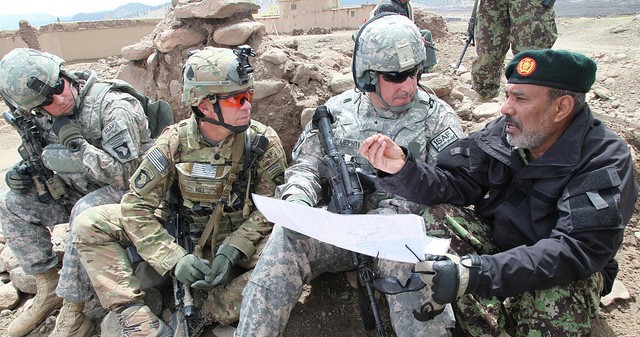
PAKTIKA, Afghanistan, April 24, 2011 -- Nearly 350 members of the Afghan National Security Forces and U.S. Army Soldiers from Task Force White Currahee air assaulted into Naka district, Afghanistan, for the first time this deployment April 10-21, 2011.
Their mission, the largest combined operations for TF White Currahee, was to clear and eliminate the insurgent staging area.
The preparation for Operation Overlord was months in the making.
"Traditionally, (insurgents) have used Naka as a staging area and bed-down location, so they can conduct operations throughout our AO (area of operations) and AOs to the south," said 1st Lt. Matthew D. Nunes, the platoon leader with 2nd Platoon, Company E "Easy", 2nd Battalion, 506th Infantry Regiment, 4th Brigade Combat Team, 101st Airborne Division. "Throughout the deployment we have been doing shaping (operations) to cut off their access to the rest of our AO and basically limit them to only being able to operate in Naka. This was our big push to take Naka away from them too."
According to Spc. Rex W. Hann, an infantryman with 1st Platoon, Company E, 2nd Battalion, 506th Infantry Regiment, 4th Brigade Combat Team, 101st Airborne Division, their mission was to disrupt any enemy that might be in the area and keep the local populace in Naka safe.
"It affects the overall security, because we have pretty much pushed the Taliban and foreign fighters to Naka, the farthest point from our (Combat Outpost), and we are trying to push them completely out of (our area of operations). Their last strong hold was in Naka," he said.
Not only did the Soldiers face the challenge of clearing unfamiliar hostile territory, they accomplished it in weather conditions that included rain, hail, cold temperatures and gusty winds with enough equipment on their backs to last a minimum of three days.
"We carried around 110 pounds worth of gear in the rain, cold and wind while we moved around the mountains in the vicinity of Naka," said Nunes.
During missions to remote villages the Soldiers face other challenges outside of the enemy threat.
"There are a lot of challenges, but one of the biggest is the communication barrier," said Hann. "It is hard to speak to the locals not knowing the language. A lot of times they won't trust the Americans because the Taliban has influenced them or told them false things about (us)."
To counter the issue, the Soldiers of Easy Company encouraged their Afghan National Police, or ANP, counterparts to take the lead when dealing with their countrymen.
"We worked with the ANP on this mission," said Spc. Sean P. Bedard, a counter-insurgency team leader with Easy Company. "It really helps to have them with us because it puts a local face on what we are trying to do, and the villagers trust these guys more because they speak the same language."
The Currahee Soldiers and their ANP partners occupied the area around Naka for more than 11 days and they faced an enemy that did not seem content attacking their combat force head on.
"(Insurgents) had left the villages by the time we got there," said Nunes. "Their only option was then to operate on the outskirts in the mountains around the towns, because they were unable to operate in the town. Tat only left them able to attack our blocking positions, our support by fire and our patrol bases."
"I think they were expecting some kind of mission to come to Naka, but I don't think they expected it to be on the level that we did," said Nunes. "I think they will be frustrated now because they won't be able to use Naka the way that they always have."
In fact, Nunes said Soldiers of Easy Company spent the majority of their deployment disrupting insurgents' lives and taking away their ability to move with ease.
"When we got to (Combat Outpost) Zerok we were getting hit with IDF (indirect fire) on a day-to-day basis," said Nunes. "The (company) made the effort to go out and do repetitive, monotonous, horrible patrols in the mountains and we took the IDF locations away from the enemy. Then, we expanded further to more and more towns and are having more and more shuras with the villagers and we have put in the work to make sure the insurgents are unable to bypass our presence."
The mission resulted in four suspected and two confirmed enemy-killed-in action, the discovery of several improvised explosive devices and an enemy that is now unable to occupy an area once known as a safe haven.
"Naka was known as the 'place where the bad guys are,'" said Nunes. "It was their safe haven. It is said that the Americans can't really go in there, but all year we have been locking down the AO. It is rewarding to finally be able to go in and say nobody has been able to go here before and now we have done it."
Hann said he is proud of what he and his fellow Currahee Soldiers accomplished.
"This (was) the last strong hold of the Taliban in our AO, and we pushed them out of this area. Now our AO will be pretty much secure, and the local people can go on about their daily lives and not have to worry about being harmed by the Taliban," said Hann. "I love my job. I love the fact that I am helping protect my fellow Americans, and that I am helping to protect the Afghans. I believe that everybody has a right to be free."
Related Links:
Regional Command (East) - Afghanistan

Social Sharing